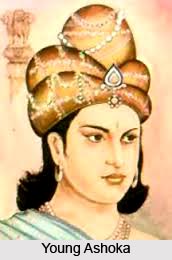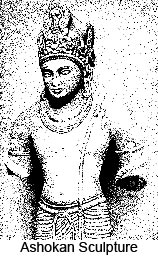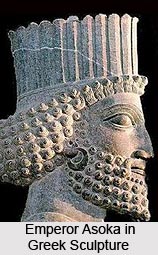 Ashoka Priyadarshi, ascended the Magadhan throne in the 273 B.C. Ashoka was one of the greatest monarchs in the Indian history and his consecration initiated a new epoch in the history of ancient India. Ashoka reigned over most of present-day India after a series of millitary conqest. Stabilizing his empire in Magadha Ashoka expanded his Empire from Afganistan to the parts of Persia in the west and to the present boundaries of West Bengal and Assam in the east and also to the distant south upto Mysore. Ashoka with his sheer sophistication introduced the measures for the spiritual and the material welfare of his subjects and left an imperishable mark in the ancient history of India. However the information regarding Ashoka`s early life and achievement is limited to the literary and the epigraphic records of the contemporary era.
Ashoka Priyadarshi, ascended the Magadhan throne in the 273 B.C. Ashoka was one of the greatest monarchs in the Indian history and his consecration initiated a new epoch in the history of ancient India. Ashoka reigned over most of present-day India after a series of millitary conqest. Stabilizing his empire in Magadha Ashoka expanded his Empire from Afganistan to the parts of Persia in the west and to the present boundaries of West Bengal and Assam in the east and also to the distant south upto Mysore. Ashoka with his sheer sophistication introduced the measures for the spiritual and the material welfare of his subjects and left an imperishable mark in the ancient history of India. However the information regarding Ashoka`s early life and achievement is limited to the literary and the epigraphic records of the contemporary era.
The inscriptions of the rock edicts and the epigraphic records of the contemporary era do not throw much light on the early life and career of Ashoka. Hence the scholars and the historians depend on the records of the Buddhist texts to etch out the details about the early life and career of Ashoka Priyadarshi. The principal source about the childhood and gradual development of Ashoka are the Buddhist text of Divyavadana and Mahavamsa. These Buddhist texts narrates that after the death of Bindusara disorder and anarchy crept up the society and there was a severe fratricidal struggle among the sons of Bindusara for the throne. Ashoka, in his early youth was involved in this struggle and is said to have killed ninety-nine of his brothers who are the possible successor of the throne of Bindusara. He appeared only the life of Tishya, who was his younger brother. Ashoka walked through the blood of his brother to the throne of Magadha. In the early years of his career, Ashoka had a violent and tyrannical disposition and hence he was popular among his subjects with he title of Chandasoka.
However the story regarding the early life and the beginning of his career as a king have been refuted by the scholars. They have put forward several statements in support of their views. According to the scholars, apart from the Buddhist texts, there was no such independent evidence, supporting the fact of the fratricidal struggle for the throne. Secondly in the Rock Edict V, Ashoka had expressed his deep love and anxious care for the family establishments of his brothers existing in the capitals and in the countries. The scholars at the same time pointed out that the Rock Edict V dated back to the thirteenth year of Ashoka`s reign. This indicates that some of Ashoka`s brother was still living and responsibly holding the charge of the provinces under Ashoka. Unless Ashoka was anxious about his family he would not have mentioned about his brother in the rock edicts. Dr. Bhandarkar has aptly pointed out that the Buddhist text emphasized the greatness of Buddhism and tried to point out that how Chandasoka converted into Dharmasoka. It was however concluded that there was probably a contest between the sons of Bindusara over the claim of the Magadhan throne and Ashoka succeeded at least against the claim of his stepbrother Susima.
 The career of Ashoka as the king of Magadha was however initiated before the four years after his consecration. The Ceylonese chronicles provide several information regarding Ashoka`s career as the king of Magadha. The historians opine that if the Ceylonese sources are true then Ashoka`s coronation was delayed probably due to the struggle for the throne of Magadha. But the scholars at the same time pointed out that there is no existing evidence in support of this "gratuitous assumption" of struggle for the throne. From the rock edicts of Ashoka it is revealed that he dated the chronology of his reign from the time of his coronation. Depending on this fact, Dr Bhandarkar has rejected the theory of "four years gap" approached by the Ceylonese texts. Eggermott however made a critical analysis of the Ceylonese texts and holds that since the Ceylonese texts maintained different chronological patterns and contained several versions, it could not provide any authentic verification about the reign of Ashoka as a king. Henceforth the Ceylonese texts are less reliable to the historians in the modern days.
The career of Ashoka as the king of Magadha was however initiated before the four years after his consecration. The Ceylonese chronicles provide several information regarding Ashoka`s career as the king of Magadha. The historians opine that if the Ceylonese sources are true then Ashoka`s coronation was delayed probably due to the struggle for the throne of Magadha. But the scholars at the same time pointed out that there is no existing evidence in support of this "gratuitous assumption" of struggle for the throne. From the rock edicts of Ashoka it is revealed that he dated the chronology of his reign from the time of his coronation. Depending on this fact, Dr Bhandarkar has rejected the theory of "four years gap" approached by the Ceylonese texts. Eggermott however made a critical analysis of the Ceylonese texts and holds that since the Ceylonese texts maintained different chronological patterns and contained several versions, it could not provide any authentic verification about the reign of Ashoka as a king. Henceforth the Ceylonese texts are less reliable to the historians in the modern days.
The historians after a prolonged controversy regarding the early life of Ashoka have unanimously opined that when Ashoka was a prince, he was appointed as the Governor of Taxila and he performed his responsibility competently. At that time he subdued successfully the rebellion of the Taxilian people. He conquered the khasa country situated between the Jhelum and Kashmir. When Bindusara fell ill Ashoka came to Pataliputra and being the most competent son ascended the throne of Magadha with the title Devanampiya Piyadasi Ashoka. Neither the contemporary manuscripts nor his own inscriptions throw much light to the ancestral parentage of Ashoka. However a group of historians have opined that Ashoka was the son of the Brahmi wife of Bindusara. Dharma or Subhadrangi, the Brahmin wife of Bindusara had two sons- Ashoka and Vigatasoka. Yet the modern scholars do not support the view and they hold a different view that Ashoka was the son of a Greek Queen of Bindusara. Later the interpreters of ancient history has opined that if the source of the modern scholars are to be believed then it may be inferred that Ashoka must be of mixed descendants and contested for the throne. The modern interpreters have also said that Ashoka`s close relation with the Greeks and his leanings towards Buddhism may be due to his mixed ancestry.
The Buddhist traditions depict that in his early life, before being a king Ashoka was appointed as the viceroy of Ujjaini. In this course of time he fell in love with Devi, the daughter of the merchant of Vidisha. Ashoka married her and had two children Mahendra and Sanghamitra by her. Later becoming a king he married again and as the Allahabad Pillar inscription depicts, Ashoka had many wives. Furthermore the Allahabad Pillar inscription narrated the story of Ashoka`s second wife Karuvaki and son Tivra. According to Dr Bhandarkar, Ashoka in his early life enjoyed the closeness with different women and had a number of concubines in different provinces under him. However there is no authentic historical document supporting the fact that Ashoka had many sons by his different wives. About the sons of Ashoka, his own inscriptions are the principal yet authentic sources. Ashoka`s inscription refers to four of kumaras (princes) who are appointed as the viceroy of three provinces namely Ujjaini, Toshila, Taxila and one Aryaputra (the crowned prince) as the viceroy of Suvarnagiri.
Ashoka`s own rock edicts are the principal surviving documents of his reign. In the Rock edict VI he depicted his own private life. According to Ashoka himself, when he was freed from the royal duties he used to sit in the dining table and enjoyed the company of the inmates of the royal palace or harem. Sometimes he used to visit the stud and enjoyed the horse ride. Rock edict VII narrated that Ashoka enjoyed the Vihara Yatra and hunting excursion, which was abolished in the subsequent years when he turned out to be a Buddhist. It is again known from the Rock Edicts I that Ashoka was very fond of meat and pea-owls. This is later corroborated by the statement of Buddhaghosa that in the 4th Century B.C, people of Maddhyadesa was very much fond of meat and peafowl.
Before embracing Buddhism as his religion, Ashoka`s career was marked with mighty conquest and the valiant warfare. Moreover he was a benevolent king and worked for the welfare of his subjects. Before being a Buddhist, he maintains the principles of tolerance and benevolence and he was popular among his subjects. Ashoka arranged festivals and or Samajas and sought to enlist the attachment of the people in order to provide them entertainment. During the festivals the people were provided with sumptuous dishes and were entertained with music, dancing, wrestling etc. In the subsequent years, Ashoka became the advocate of non-violence and abolished the sumptuous dish of the Samajas where meat was the principal food. Moreover he introduced several administrative reforms including the release of the prisoners in every year of his coronation, in order
Ashoka, the great is often ranked among the greatest monarch of ancient India. As the historical records depicting his early life and career suggest, Ashoka, before embracing Buddhism was a mighty conqueror and a sophisticated solicitor of the welfare of the people.



















